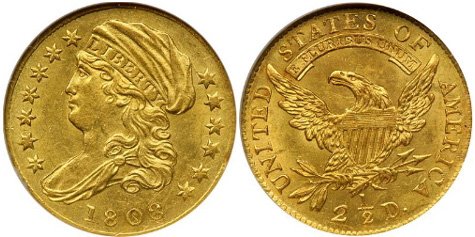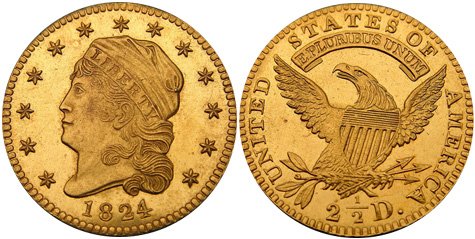Guide to U.S. Capped Bust Quarter Eagles
The quarter eagles struck from 1808 to 1834 can be grouped into the series known as the Capped Bust Quarter Eagles, although various other names have been used and the name has also been applied to the previous series. To make matters more complex, the series is divided into three subtypes, which are sometimes considered separately. Regardless of the nomenclature, all coins within this range are rare due to their extremely low mintages and the impact of melting after the weight of the denomination was reduced in 1834.

The original designer of the Capped Bust Quarter Eagle was John Reich, a German immigrant who had been hired as Assistant Engraver for the Chief Engraver Robert Scot. Reich’s new design was part of an ongoing project to redesign all of the circulating denominations, replacing many of the designs previously created by Scot.
The new obverse design features a bust of Liberty, facing left. A true Phrygian cap is placed on her head, with the word LIBERTY on a band. Thirteen stars are around the bust, configured seven to the left and six to the right, while the date is placed below. The reverse design carries an eagle with a more natural appearance than the previous design. Its wings are spread with a shield at its breast, and its claws grasp an olive branch and three arrows. The inscription E PLURIBUS UNUM appears on a scroll above the eagle, while UNITED STATES OF AMERICA appears around. The denomination is expressed as “2 1/2 D.” below the eagle.

This initial design was only struck for a single year in 1808, followed by a gap in production for the denomination until 1821. The quarter eagle was not much needed in commerce, and the larger half eagles and eagles were preferred for international trade. By the time the production of the quarter eagle had resumed, John Reich had left the Mint, and his design is believed to have been modified by the aging Robert Scot.
The quarter eagles issued from 1821 to 1827 featured a modified head of Liberty, noticeably different from the original design by John Reich. The truncation of the neck is higher and the head of Liberty is much more compact. The thirteen stars are now positioned evenly around the portrait, no longer separated by Liberty’s head. Another noticeably different feature is the addition of denticles around the rim on both the obverse and reverse, as the result of more modern machinery in use at the Mint.
After brief gap in production, the quarter eagles issued from 1829 through 1834 would see another modification. The diameter would be reduced from 18.5 mm to 18.2 mm, coinciding with the use of a “close collar” at the Mint. Consequently, the design was slightly altered as well, by reducing the size of the lettering and stars. The close collar, which had been first used on dimes in 1828, resulted in a raised rim and the addition of a reeded edge upon striking the coins. This was a major improvement at the Mint, resulting in faster production and more standardized coinage.

